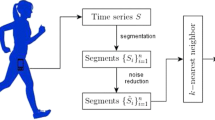Abstract
Human activity recognition (HAR) has mainly been directed to the recognition of static or quasi-periodic activities like sitting, walking or running, typically for fitness applications. However, activities like eating or drinking are neither static nor quasi-periodic. Instead, they are composed of sparsely occurring motions or gestures in continuous data streams. This paper presents a novel adaptive segmentation technique based on crosses of moving averages to identify potential eating or drinking gestures from accelerometer data. The novel crossings-based segmentation approach proposed is able to identify all eating and drinking gestures from continuous accelerometer data including different activities. A posteriori, potential gestures are classified as food or drink intake gestures using a combination of Dynamic Time Warping (DTW) as signal similarity measure and a k-Nearest Neighbours (KNN) classifier. An outstanding classification rate of 100% has been achieved.
Access this chapter
Tax calculation will be finalised at checkout
Purchases are for personal use only
Similar content being viewed by others
References
Amft, O., Bannach, D., Pirkl, G., Kreil, M., Lukowicz, P.: Towards wearable sensing-based assessment of fluid intake. In: 2010 8th IEEE International Conference on Pervasive Computing and Communications Workshops (PERCOM Workshops), pp. 298–303. IEEE (2010)
Bayat, A., Pomplun, M., Tran, D.A.: A study on human activity recognition using accelerometer data from smartphones. Procedia Comput. Sci. 34, 450–457 (2014)
Casale, P., Pujol, O., Radeva, P.: Human activity recognition from accelerometer data using a wearable device. In: Pattern Recognition and Image Analysis, pp. 289–296 (2011)
Junker, H., Amft, O., Lukowicz, P., Tröster, G.: Gesture spotting with body-worn inertial sensors to detect user activities. Pattern Recogn. 41(6), 2010–2024 (2008)
Keogh, E., Chu, S., Hart, D., Pazzani, M.: Segmenting time series: a survey and novel approach. In: Data mining in time series databases, pp. 1–21. World Scientific (2004)
Lovrić, M., Milanović, M., Stamenković, M.: Algoritmic methods for segmentation of time series: an overview. J. Contemp. Econ. Bus. Issues 1(1), 31–53 (2014)
Noor, M.H.M., Salcic, Z., Kevin, I., Wang, K.: Adaptive sliding window segmentation for physical activity recognition using a single tri-axial accelerometer. Pervasive Mob. Comput. 38, 41–59 (2017)
Ravi, N., Dandekar, N., Mysore, P., Littman, M.L.: Activity recognition from accelerometer data. In: AAAI, pp. 1541–1546 (2005)
Xu, R., Zhou, S., Li, W.J.: Mems accelerometer based nonspecific-user hand gesture recognition. IEEE Sens. J. 12(5), 1166–1173 (2012)
Zhang, M., Sawchuk, A.A.: Motion primitive-based human activity recognition using a bag-of-features approach. In: Proceedings of the 2nd ACM SIGHIT International Health Informatics Symposium, pp. 631–640. ACM (2012)
Author information
Authors and Affiliations
Corresponding author
Editor information
Editors and Affiliations
Rights and permissions
Copyright information
© 2019 Springer Nature Switzerland AG
About this paper
Cite this paper
Anderez, D.O., Lotfi, A., Langensiepen, C. (2019). A Novel Crossings-Based Segmentation Approach for Gesture Recognition. In: Lotfi, A., Bouchachia, H., Gegov, A., Langensiepen, C., McGinnity, M. (eds) Advances in Computational Intelligence Systems. UKCI 2018. Advances in Intelligent Systems and Computing, vol 840. Springer, Cham. https://doi.org/10.1007/978-3-319-97982-3_32
Download citation
DOI: https://doi.org/10.1007/978-3-319-97982-3_32
Published:
Publisher Name: Springer, Cham
Print ISBN: 978-3-319-97981-6
Online ISBN: 978-3-319-97982-3
eBook Packages: Intelligent Technologies and RoboticsIntelligent Technologies and Robotics (R0)




